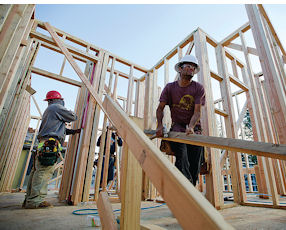The sudden surge in the housing market here in Southern California has caught most people by surprise – and is causing worry among some circles. Double-digit price increases, tight inventories and bidding wars across the region – including the hard hit San Fernando Valley – all sound too much like what was going on at the height of the last real estate bubble – the aftermath of which continues to reverberate. But worrying may be premature as the numbers tell us it’s still too early to call this the next bubble. It’s hard to believe that only a year ago media reports were still focused on when the housing market was going to bottom out. One news article called the slowing of price declines a hopeful sign of recovery as other doomsayers were talking about a double dip following a second wave of foreclosures. California’s attorney general was pushing a series of foreclosure reforms dubbed the Homeowners Bill of Rights as essential to healing the housing market. But both the press and policymakers were looking at prices as the leading indicator – which they are not. Prices lag, inventories lead, and inventories have been on a downward trajectory for well over two years. The recovery was in the works well before prices started to rise at today’s heady trajectory. Now the discussion shifts from how to fix the market to how to break it again. After all, on the surface things certainly look like 2006 with less than three months of inventory and investors playing a big role in bidding wars. But dig away at the statistics and this really isn’t anything like 2006. Yes, median prices are up – but not by that much. A recent release from the Southland Regional Association of Realtors reports that the median single-family home price in the San Fernando Valley has hit $422,000, an increase of 19 percent since one year ago. But we have to remember that the median price does not control for the quality of the housing stock being bought and sold. Price increases could mean that the price of all homes is going up, or that the average quality of the homes being sold today is higher than it was one year ago. Indeed, the latter explains well over half of the current price increase because the number of foreclosures in the mix – which typically sell at discount – is down considerably from a year ago. Other quality-adjusted numbers such as Case Shiller put the increase at less than 10 percent. High, but not exploding. As for buyers, in 2006 the market was being driven by the incredible availability of credit when just about anyone could get any loan to buy any house. Today, credit remains tight. And in 2006 investors bought to flip. Today, they buy to rent. It’s an entirely different strategy built on fundamentals, not on riding a wave. And what are those fundamentals? The amazingly cheap cost of housing relative to rent in Los Angeles today. In 2000, the median price of a house in Los Angeles County was $206,000 and interest rates were running at 8 percent. The monthly cost of that house, assuming for simplicity a 100 percent loan to value mortgage and adding property taxes, was a little over $1,700. The average monthly rent for an apartment in 2000 was $1,000 making the home cost-to-rent ratio 1.73. At the peak of the bubble in 2006 that ratio had risen to 2.9 – incredibly high and indicative of how misaligned prices were because renting was so much cheaper. Today, rental markets are tight given all the movement into rental housing following foreclosure – 10 percent higher than in 2006, despite double-digit unemployment. And as home prices and interest rates have dropped sharply, the home cost-to-rent ratio now sits at an all-time low of 1.3. It’s no wonder investors are leaping in. Median prices would have to get back to $470,000 before the ratio rose to 2000 levels. Could prices rise to this level? Maybe. But certain pressures are likely to cool things off. Credit is tight, so as prices increase, demand will cool because price-to-income levels will rise and limit potential buyers. Also, rental markets will cool with more buyers and slow investor demand. Another factor is that as prices rise, many formerly “underwater” owners will be able to sell their properties, which will increase inventories. Banks are still processing quite a few properties as well, which will continue to add to supply. And builders are rushing to build units to meet the unexpected demand. But remain wary. Today’s recovery could turn into another bubble if we forget to pay attention to fundamentals and instead focus on that age-old, yet disastrous, investment strategy – the trend is your friend. Christopher Thornberg, Ph.D. is an economist and founding partner of Beacon Economics LLC in Los Angeles.
